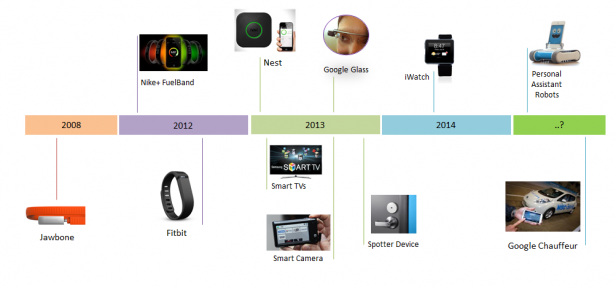This is the 7th and last post in our series ‘Real-time Data Visualization.’
In this post, we briefly trace the history of real-time analytics, and then move on to identifying 7 overarching trends that will influence the way we use real-time data in the future.
One of the earliest applications of real-time analytics was in manufacturing plants to monitor the performance and health of their systems in real-time. Data like temperature, weight, and volume were monitored by sensors embedded at strategic points in a manufacturing system. These sensors would update monitoring dashboards in real-time, giving visibility and control over the performance, and output. Not just in systems, but RFID technology and surveillance cameras drastically increased the applications of real-time analytics in security, and human resource allocation in these manufacturing plants. It would be only a matter of time till this kind of recording of real world information was made possible outside the manufacturing, and industrial sectors.
 Today, we see a wave of connected devices that are flooding the consumer market, and throwing open new doors of opportunity for consumers and businesses alike. Makes us wonder what the future of real-time analytics holds for us. Here are 7 trends that could turn out to be defining factors as the future of real-time analytics unfolds:
Today, we see a wave of connected devices that are flooding the consumer market, and throwing open new doors of opportunity for consumers and businesses alike. Makes us wonder what the future of real-time analytics holds for us. Here are 7 trends that could turn out to be defining factors as the future of real-time analytics unfolds:
 We’ve only seen the beginning of connected devices that can perform user-specified tasks. For example, Spotter can be programmed to send an alert via SMS or email if there’s a change in temperature of an appliance. IFTTT, a popular automation tool, makes it extremely easy to specify ‘if this then that’ functions on some of our most commonly used apps like Gmail, Evernote, Twitter, and Facebook. This sort of technology, though in its infancy now, is set to grow exponentially in the coming years. Increasingly, we’ll see this trend pick up pace in business scenarios as well. Big data technologies will allow businesses to crunch huge volumes of data to execute specific functions automatically. Personalized marketing campaigns, laser-focussed sales pitches, and intuitive support are some of the business applications of this technology.
We’ve only seen the beginning of connected devices that can perform user-specified tasks. For example, Spotter can be programmed to send an alert via SMS or email if there’s a change in temperature of an appliance. IFTTT, a popular automation tool, makes it extremely easy to specify ‘if this then that’ functions on some of our most commonly used apps like Gmail, Evernote, Twitter, and Facebook. This sort of technology, though in its infancy now, is set to grow exponentially in the coming years. Increasingly, we’ll see this trend pick up pace in business scenarios as well. Big data technologies will allow businesses to crunch huge volumes of data to execute specific functions automatically. Personalized marketing campaigns, laser-focussed sales pitches, and intuitive support are some of the business applications of this technology.
 Businesses will realize that the big data revolution is not really about the technology, but about the change in culture and mindset. This will push them to re-think how they access, process, and use data. Rather than build the one all-encompassing tool that handles all data, the norm will be to let the tools serve the purpose. We’re already seeing signs of that with real-time aggregation dashboards like Geckoboard. Executives will awaken to the possibility of accessing data using flexible methods in a way that wasn’t possible before.
Businesses will realize that the big data revolution is not really about the technology, but about the change in culture and mindset. This will push them to re-think how they access, process, and use data. Rather than build the one all-encompassing tool that handles all data, the norm will be to let the tools serve the purpose. We’re already seeing signs of that with real-time aggregation dashboards like Geckoboard. Executives will awaken to the possibility of accessing data using flexible methods in a way that wasn’t possible before.
Table of Contents
The Internet of Things
 Today, we see a wave of connected devices that are flooding the consumer market, and throwing open new doors of opportunity for consumers and businesses alike. Makes us wonder what the future of real-time analytics holds for us. Here are 7 trends that could turn out to be defining factors as the future of real-time analytics unfolds:
Today, we see a wave of connected devices that are flooding the consumer market, and throwing open new doors of opportunity for consumers and businesses alike. Makes us wonder what the future of real-time analytics holds for us. Here are 7 trends that could turn out to be defining factors as the future of real-time analytics unfolds:
1. The Internet of Things will grow in leaps and bounds
In the past two decades, the explosion of data across the internet is largely credited to the availability of devices like digital cameras, and mobile phones. However, this is just the begining. Gartner estimates 20B connected devices by 2020, a 30-fold increase from what we see today. We’ve already seen successful products from Nike Fuelband, Fitbit, and Jawbone Up, which offer a variety of wearable devices that capture data about a user’s physical activity in real-time. Smart devices are even invading our home in the form of smart TVs, and other connected home appliances. The interest isn’t restricted to just the consumer electronics companies, even Google with their Google Glass, and self-driving cars are pushing the limits of what devices can do for us. Apple has a rumoured iWatch product in the pipeline, and some companies are betting on robots being our personal assistants of the future. All these devices, while assisting us in our daily lives, will add to the amount of real-time data available. This has raised privacy concerns by some, but the opportunities it presents are too alluring to avoid.2. Consumer technology has a boomerang effect on businesses
At the start of this post we saw how real-time technology has its origins in manufacturing businesses, after which it trickled down to the consumer space, particularly with mobile phones. However, what we’re seeing now, with the advent of the social web, and explosion of connected devices is a reversal of that trend. Consumer technology is changing the way we do business. Work culture is being changed by policies like ‘Bring your own device’, and enterprise applications that are borrowing design principles from popular consumer applications. Companies are embracing social media platforms for their sales, marketing, support, recruiting, and other key functions. Even traditional B2B platforms like SalesForce have been expanding their offerings to embrace the social web.3. Automation will become mainstream
 We’ve only seen the beginning of connected devices that can perform user-specified tasks. For example, Spotter can be programmed to send an alert via SMS or email if there’s a change in temperature of an appliance. IFTTT, a popular automation tool, makes it extremely easy to specify ‘if this then that’ functions on some of our most commonly used apps like Gmail, Evernote, Twitter, and Facebook. This sort of technology, though in its infancy now, is set to grow exponentially in the coming years. Increasingly, we’ll see this trend pick up pace in business scenarios as well. Big data technologies will allow businesses to crunch huge volumes of data to execute specific functions automatically. Personalized marketing campaigns, laser-focussed sales pitches, and intuitive support are some of the business applications of this technology.
We’ve only seen the beginning of connected devices that can perform user-specified tasks. For example, Spotter can be programmed to send an alert via SMS or email if there’s a change in temperature of an appliance. IFTTT, a popular automation tool, makes it extremely easy to specify ‘if this then that’ functions on some of our most commonly used apps like Gmail, Evernote, Twitter, and Facebook. This sort of technology, though in its infancy now, is set to grow exponentially in the coming years. Increasingly, we’ll see this trend pick up pace in business scenarios as well. Big data technologies will allow businesses to crunch huge volumes of data to execute specific functions automatically. Personalized marketing campaigns, laser-focussed sales pitches, and intuitive support are some of the business applications of this technology.


